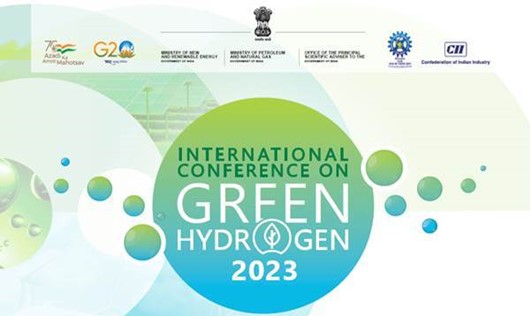- Courses
- GS Full Course 1 Year
- GS Full Course 2 Year
- GS Full Course 3 Year
- GS Full Course Till Selection
- Online Program
- GS Recorded Course
- NCERT (Recorded 500+ Hours)
- Polity Recorded Course
- Geography Recorded Course
- Economy Recorded Course
- AMAC Recorded Course
- Modern India, Post Independence & World History
- Environment Recoded Course
- Governance Recoded Course
- Science & Tech. Recoded Course
- International Relations and Internal Security Recorded Course
- Disaster Management Module Course
- Ethics Recoded Course
- Essay Recoded Course
- Current Affairs Recoded Course
- CSAT
- 5 LAYERED ARJUNA Mentorship
- Public Administration Optional
- ABOUT US
- OUR TOPPERS
- TEST SERIES
- FREE STUDY MATERIAL
- VIDEOS
- CONTACT US
ROADMAP FOR GREEN HYDROGEN ECOSYSTEM IN INDIA
ROADMAP FOR GREEN HYDROGEN ECOSYSTEM IN INDIA
07-07-2023

Latest Context
In order to explore how we can create a Green Hydrogen ecosystem and foster a systemic approach for meeting the global goals for decarbonization through Green Hydrogen, the government has brought stakeholders from India and around the world together as part of its quest towards energy transition.
- The Union Minister for Power and New and Renewable Energy opened the three-day International Conference on Green Hydrogen (ICGH-2023), which will be held from July 5–7, 2023, at Vigyan Bhawan in New Delhi.
- Leaders in science, politics, academia, and business from across the world will convene at the conference to talk about new developments and emerging technologies affecting the whole value chain for green hydrogen.
- The conference will give industry players the chance to examine the sector's changing green hydrogen environment and innovation-driven solutions, enhancing the sector's sustainability ecosystem.
Key Points
- It aims to solve the difficulties and economic viability of the green hydrogen production ecosystem, including its transportation and storage.
- The proposal suggests three important strategies for research and development in green hydrogen: Blue Sky Projects (a long-term intellectual property strategy), a mission-mode approach for electrolysers, and the Grand Challenge to support startups.
- Green Hydrogen Production: It can be made using electrolysis, photoelectrochemical water splitting, dark fermentation, bio-photolysis, and other processes.
- Hydrogen Storage:
- It can be stored in a different form.
- Underground storage in geological formations including salt caverns, exhausted oil and gas reserves, and aquifers can be used to create large-scale storage.
- Small amounts can be kept in solid-state, compressed, or liquified form.
- Hydrogen transport:
- Solid transport: Absorbed as metal hydride and transported in solid form then later released by desorption process.
- Liquid transport: Liquefied hydrogen transported in cryogenic containers.
- Gaseous transport: Compressed hydrogen moved in pipelines or in tanks.
- Chemical Conversion: Hydrogen is converted into methanol, ammonia, or synthetic natural gas (SNG) and transported.
Significance of Green Hydrogen
- In order for India to achieve its Nationally Determined Contribution (INDC) Targets and guarantee regional and governmental energy security, access, and availability, green hydrogen energy is essential.
- Future renewable energy intermittencies will need the use of energy storage, which green hydrogen may provide.
- In terms of transportation, green hydrogen may be utilised in trains, huge ships, buses, trucks, and other vehicles for long distance mobilisations for either urban freight movement within cities and states or for people.
- The primary renewable energy source for supporting infrastructure has the potential to be hydrogen.
Associated Challenges
- Economic Sustainability: The industry's main obstacle to using hydrogen for industrial purposes is how to extract green hydrogen profitably. Currently, the majority of low-cost electricity-producing renewable energy sources are dispersed far from potential demand centres. The economics of hydrogen transportation would suffer greatly if it had to be delivered.
- Legal Hurdle: Cross-state open access electricity operations were envisioned under the Electricity Act of 2003. This, however, has not been carried out in letter and spirit. The cost of providing open-access power might quadruple if this obstacle is not removed.
Way Forward
- Decentralised Production: An electrolyser (which uses electricity to split water into H2 and O2) must have free access to renewable energy in order to promote decentralised hydrogen production.
- Minimising Intermittency: Mechanisms are required to provide continuous availability to renewable energy for the decentralised hydrogen manufacturing process. Fuel cells can provide a constant supply of hydrogen, minimising the intermittency associated with renewable energy.
- Augmenting Production: The economics of the fuel will be greatly enhanced by increasing the supply dependability of hydrogen and supplementing environmentally friendly hydrogen with conventionally generated hydrogen. In this regard, actions like incorporating green hydrogen into current processes, particularly in the industrial sector, might be helpful.
- Providing Finance: Investments in early-stage piloting and the research and development required to enhance the technology for usage in India must be facilitated by policymakers.



